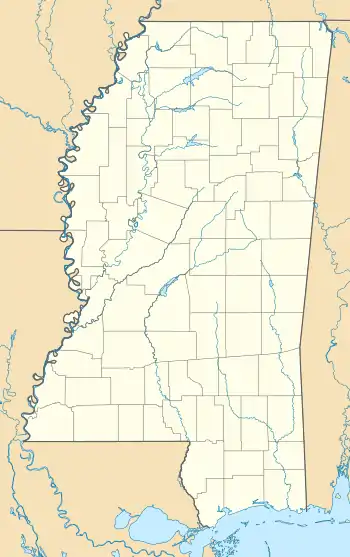Stovall, Mississippi
Stovall, also known as Prarieville,[2] is an unincorporated community in Coahoma County, Mississippi, United States, along Mississippi Highway 1, 7 miles (11 km) north of Sherard and approximately 6 miles (9.7 km) south of Friars Point.
Stovall, Mississippi | |
|---|---|
 Stovall  Stovall | |
| Coordinates: 34°17′48″N 90°38′41″W | |
| Country | United States |
| State | Mississippi |
| County | Coahoma |
| Elevation | 174 ft (53 m) |
| Time zone | UTC-6 (Central (CST)) |
| • Summer (DST) | UTC-5 (CDT) |
| ZIP code | 38614 |
| Area code(s) | 662 |
| GNIS feature ID | 692248[1] |
History
Stovall is named after the Stovall family, who owned the land where the railroad depot was located.[3] It is located on the former Yazoo and Mississippi Valley Railroad and in 1910 was home to two general stores.[2] The Stovall Gin Company once operated a cotton gin in Stovall.[4]
Although Stovall is unincorporated, it has a ZIP code of 38614. A post office operated under the name Prarieville from 1878 to 1885 and began operating under the name Stovall in 1885.[5]
Ethnomusicologist Alan Lomax recorded Muddy Waters in 1941 and 1942 in Stovall.[6]
Carson Mounds, a large Mississippian culture archaeological site, is located in Stovall.[7]
Notable people
- Eddie Boyd, blues pianist, singer, and songwriter[8]
- Willie Morganfield, gospel musician and minister[9]
- William Howard Stovall, World War I flying ace, World War II fighter pilot[10]
- Muddy Waters, blues singer-songwriter[11]
References
- U.S. Geological Survey Geographic Names Information System: Stovall, Mississippi
- Howe, Tony. "Stovall, Mississippi". Mississippi Rails. Retrieved 11 June 2020.
- Paul Schullery (1988). The Bear Hunter's Century. Stackpole Books. p. 62. GGKEY:J0EG9FBEF9S.
- The Code of Federal Regulations of the United States of America. U.S. Government Printing Office. 1976. p. 465.
- "Coahoma County". Jim Forte Postal History. Retrieved 11 June 2020.
- Elder, Robert (19 August 2005). "The day Muddy Waters heard himself sing the blues". The Chicago Tribune. Retrieved 11 June 2020.
- Calvin S. Brown (5 March 2012). Archeology of Mississippi. Univ. Press of Mississippi. p. 108. ISBN 978-1-61703-349-0.
- Mitsutoshi Inaba (2011). Willie Dixon: Preacher of the Blues. Scarecrow Press. p. 73. ISBN 978-0-8108-6993-6.
- Alan Young (1997). Woke Me Up This Morning: Black Gospel Singers and the Gospel Life. Univ. Press of Mississippi. p. 211. ISBN 978-0-87805-944-7.
- Charles Patrick Joseph Mooney (1920). The Mid-South and Its Builders: Being the Story of the Development and a Forecast of the Future of the Richest Agricultural Region in the World. Mid-South Biographic and Historical Association. p. 626.
- Marlo Carter Kirkpatrick (1 July 2010). Mississippi Off the Beaten Path®: A Guide to Unique Places. Rowman & Littlefield. p. 77. ISBN 978-0-7627-6563-8.

